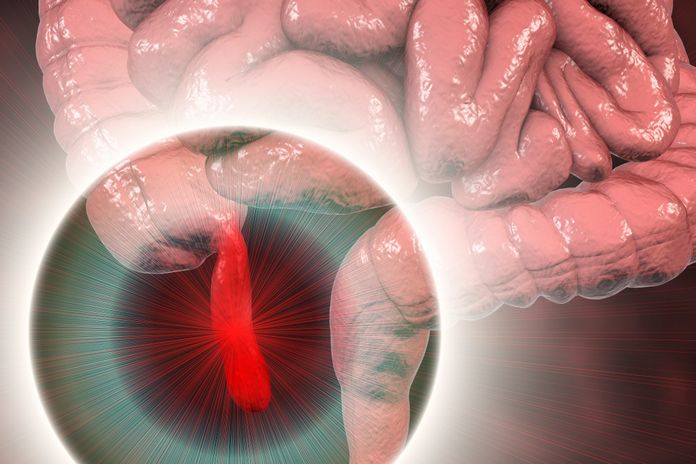Appendicitis
The appendix, or vermiform appendix, is a small, thin tube that is about 3 inches long. It is a worm-like structure that hangs down from the large intestine and is located in the lower right side of the abdomen. The appendix has no known function. The appendix is not essential for life, and removal of it does not seem to cause any problems or health complications. (1)
Appendicitis is an inflammation of the appendix. It is a condition that results when the appendix becomes inflamed due to infection or other causes. This condition is relatively common, affecting about 1 in 25 people at some point in their lives. Appendicitis affects about 1 in 500 people each year in the United States. It occurs more often in males and in whites than in females and in persons of other races. Appendicitis can affect people of any age, but it is most commonly seen in people between the ages of 12 and 30 years.
The cause of appendicitis is not known. Bacteria may enter the appendix through a wound in its wall or perhaps through the opening where the appendix joins the large intestine. Once inside, these bacteria may multiply and produce toxins that cause inflammation. If left untreated, appendicitis can lead to serious complications such as peritonitis (inflammation of the abdominal cavity) or sepsis (a potentially life-threatening infection).
There are several treatment options for appendicitis, depending on how severe it is. Mild cases may only require antibiotics and rest. More severe cases may require surgery to remove the appendix. This can be done either through traditional open surgery or laparoscopy, which is a less invasive surgery using small instruments inserted through tiny incisions in the abdomen. We will discuss the treatment in detail in the treatment section of this blog.
A recent study has found that surgery is more effective than antibiotics in treating appendicitis. The study, conducted by a team of surgeons at the University Of Washington School Of Medicine, found that patients who underwent surgery were nearly twice as likely to be cured of their appendicitis as those who received antibiotics alone.
The study looked at nearly 200 patients with confirmed cases of appendicitis. Approximately half of the patients underwent surgery to remove their appendix, while the other half received antibiotics alone. After one year, 88 percent of the patients who had undergone surgery were cured of their appendicitis, compared to just 47 percent of those who had received antibiotics alone.

Pathophysiology
When the appendix becomes obstructed, bacteria trapped within the appendiceal lumen multiply, causing the appendix to swell. Congestion and ischemia occur in the appendix due to increased intraluminal pressure. An inflammatory reaction caused by bacterial infection and ischemia leads to necrosis and gangrene. It is possible for the appendix to perforate when it becomes gangrenous. It usually takes 72 hours for obstruction to progress to perforation. (2)
According to one study, appendiceal perforation is more common in children than in adults. There was a significant risk of perforation within 24 hours of onset (7.7%), and the risk increased with the duration of symptoms. A significantly increased risk of perforation is associated with prehospital delay than with in-hospital delay, even though the duration of symptoms before surgery is directly related to the duration of symptoms before surgery.
In the early stages of appendicitis, the patient may feel only periumbilical pain due to the innervation of the appendix by T10. An exudate forms on the appendiceal serosal surface as the inflammation worsens. An intense and localized pain develops when the exudate touches the parietal peritoneum.
As a result of perforation, inflammatory fluid and bacteria are released into the abdominal cavity. Inflammation of the peritoneal surface further leads to peritonitis. Localized or diffuse peritonitis depends on how well the omentum and adjacent bowel loops contain luminal spillage.
Pain and tenderness may be localized to the abscess site if the contents wall off and form an abscess. Pain and tenderness become generalized if the contents are not walled off and fluid can travel throughout the peritoneum.

